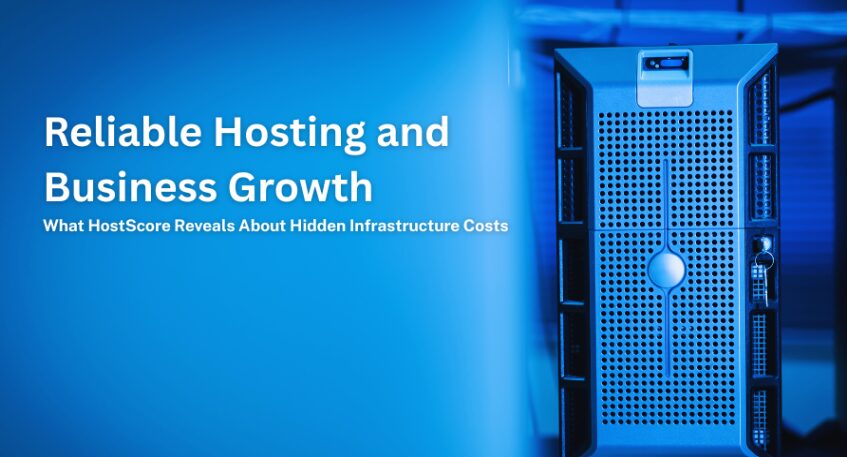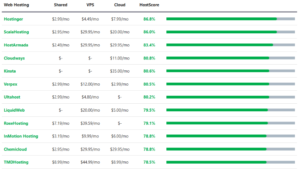Reliable web hosting is a foundational part of running a stable and profitable online business. Whether you’re selling handmade products, running a coaching platform, or growing a local service business, your website’s performance impacts every stage of customer interaction, from search engine visibility to checkout success.
But the true cost of web hosting isn’t always visible on the price tag.
Many business owners pick a hosting plan based on monthly cost, not realizing that downtime, poor support, or slow server speeds could quietly eat into their profits.
This is where long-term infrastructure decisions come into play. Platforms like HostScore track and compare the real-world performance of hosting providers, revealing how much value (or loss) a business may be getting from its hosting setup.
In this article, we’ll break down what hidden hosting costs look like, how they affect business growth, and how performance data can guide smarter hosting decisions.
What Are Hidden Infrastructure Costs in Hosting?
Hidden infrastructure costs refer to the indirect expenses and lost revenue caused by poor web hosting performance. These costs don’t show up on your invoice, but they impact business results in ways that are easy to overlook.
For example, if a web host has frequent downtime, your website might go offline during a product launch or while customers are browsing. If server response times are high (measured by Time to First Byte or TTFB), your site will load slowly – which leads to higher bounce rates and lower conversions.
Even support delays can create hidden costs. Imagine a weekend outage where it takes your host 12 hours to respond. The actual downtime may only be a few hours, but the impact on trust, revenue, and reputation can be much longer-lasting.
In many HostScore reviews, we’ve seen top-tier hosting providers outperform budget ones not just in uptime but also in consistency – delivering smooth performance under traffic spikes or plugin-heavy setups. These performance gaps translate into real-world differences in marketing ROI, customer retention, and operational stability.
Why Most Businesses Underestimate Hosting Costs
Many small business owners look at hosting primarily as a fixed monthly expense, be it $5, $10, or $25 per month, and make decisions based on visible pricing tiers. However the true cost of hosting often includes issues that aren’t listed in the pricing table.
One common example is resource throttling on shared hosting plans. A provider might advertise “unlimited” bandwidth or storage, but quietly restrict CPU or RAM usage when traffic increases. This can cause site slowdowns or timeouts just when visitors are most active.
Another overlooked factor is renewal pricing. Many web hosts offer low introductory rates for the first year but charge 2 – 3x more upon renewal. Without factoring in this price jump, businesses may find themselves stuck or forced to migrate unexpectedly.
Support quality is also rarely evaluated during purchase. A slow or unresponsive support team can create hours of unnecessary downtime during critical events like a sale or plugin update. These hours represent lost income and added stress, especially for business owners without a technical team.
How HostScore Reveals These Gaps?
Most hosting providers showcase similar claims: 99.9% uptime, fast performance, “24/7” support. These statements sound promising but they’re often unverifiable from the customer’s side.
HostScore addresses this gap by publishing real-world data based on independent monitoring and user experience. Every host reviewed on our platform is scored using multiple criteria: uptime stability, server speed (measured across global locations), customer support response time, and overall value.
This scoring isn’t static. Host performance is tracked and updated regularly, allowing users to see patterns over time.
For instance, some providers perform well in North America but lag significantly in Asia or Europe. Others might score high for speed but fall short in uptime or support. These inconsistencies can be critical for businesses that serve international audiences or rely on high-availability storefronts.
By comparing providers using HostScore’s rankings, business owners can identify hosts that not only perform well but also maintain that performance consistently, reducing the risk of costly surprises down the line.
Real-Life Scenarios: Impact on Business Growth
Poor hosting doesn’t just create technical issues—it impacts revenue, credibility, and scalability. Here are three examples that show how hosting can silently hold back business growth:
- A Slow Online Store Loses Sales
A WooCommerce store with poor server response times experiences higher cart abandonment. Even a one-second delay can reduce conversions by ~7%. The site may appear fine during testing but slow down significantly during sales or ad campaigns when traffic increases.
- A Freelance Portfolio Becomes Unreliable
A freelance designer hosts their portfolio and project archives on a shared server. Intermittent downtime or slow loading makes the site seem unprofessional. The result? Missed opportunities and damaged first impressions.
- A SaaS Tool Outgrows Its Hosting
A startup launches an MVP on shared hosting to save costs. But as users sign up, database performance suffers, and pages load inconsistently. Without scalable infrastructure, the team is forced to migrate under pressure – losing both development time and customer trust.
In each of these cases, the upfront hosting cost seemed reasonable. But the downstream impact of poor performance led to revenue loss, growth delays, and avoidable stress.
Choosing Hosting with Long-Term Value in Mind
The best hosting plan is the one that supports your business goals without creating bottlenecks.
Here’s a short checklist to help evaluate hosting plans beyond pricing:
- Performance benchmarks: Check for speed, TTFB, and uptime data, ideally from independent sources.
- Clear resource limits: Understand what you’re getting in terms of CPU, RAM, storage, and bandwidth. Avoid “unlimited” offers without clarity.
- Scalability: Choose a provider that offers room to grow including both vertical and horizontal upgrades, add-ons, or easy plan transitions.
- Server location options: Hosting closer to your customer base improves speed and reliability.
- Transparent pricing: Watch out for aggressive renewal fees or forced upgrades. Always read the fine print.
- Responsive support: Fast, competent customer service is crucial, especially when things go wrong.
For small business owners and founders, investing in a reliable host can pay off in fewer disruptions, better user experience, and improved conversion rates. A few extra dollars per month can often prevent much larger costs later.
Conclusion
Hosting decisions can have a lasting impact on how your business performs online. While upfront pricing is easy to compare, the real costs often come from what’s not visible: Slow servers, downtime, limited scalability, and unreliable support.
These hidden infrastructure costs can quietly undermine your growth, especially when you’re running an online store, offering client services, or scaling a digital product. They affect everything from SEO rankings to customer trust.
Choosing a reliable hosting provider means thinking beyond the monthly fee. Look for consistent performance, honest pricing, and a support system that respects your time. Independent reviews and monitoring platforms like HostScore can help fill in the gaps left by marketing promises so you can make decisions based on real-world performance, not just feature lists.
If your business depends on its website, your hosting should be an investment, not a gamble.




































